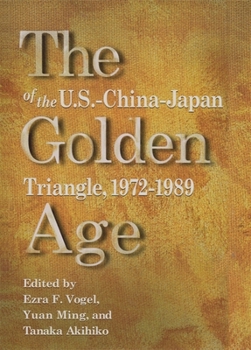The Golden Age of the U.S.-China-Japan Triangle, 1972-1989
(Book #216 in the Harvard East Asian Monographs Series)
A collaborative effort by scholars from the United States, China, and Japan, this volume focuses on the period 1972-1989, during which all three countries, brought together by a shared geopolitical strategy, established mutual relations with one another despite differences in their histories, values, and perceptions of their own national interest. Although each initially conceived of its political and security relations with the others in bilateral terms, the three in fact came to form an economic and political triangle during the 1970s and 1980s. But this triangle is a strange one whose dynamics are constantly changing. Its corners (the three countries) and its sides (the three bilateral relationships) are unequal, while its overall nature (the capacity of the three to work together) has varied considerably as the economic and strategic positions of the three have changed and post-Cold War tensions and uncertainties have emerged. In considering this special era, when the three major powers in the East Asia region engaged in positive interaction, the essays in this volume highlight the importance of this triangular reality in achieving a workable framework for future regional and global cooperation.
Format:Hardcover
Language:English
ISBN:0674009606
ISBN13:9780674009608
Release Date:November 2002
Publisher:Harvard University Press
Length:286 Pages
Weight:1.23 lbs.
Dimensions:0.9" x 6.3" x 9.4"
Customer Reviews
1 rating
The Rashomon of history
Published by Thriftbooks.com User , 18 years ago
Recent events in Northeast Asia have reinforced the importance and salience of US-China-Japan relations. These political relationships are generally described, analyzed and maintained from a bilateral perspective. However, as the title suggests, the editors of "The Golden Age of the US-China-Japan Triangle, 1972-1989" maintain that during this particular timeframe, the relationships of each country were not only amicable, but also connected to a degree in which they could be described as an economic and political "constructive triangle". It is often said that you can not know where you are going until you know where you have been. In that regard this book offers a detailed look at the historical evolution of US-Japan-China relations and gives a clue of what the future may hold. The editors, respected scholars from Harvard, Peking and Tokyo Universities, have collected nine essays from academics of each country. These authors detail what conditions prompted this brief period of cooperation to blossom, what maintained it, and lastly, what factors brought the era to an end. Furthermore, they examine in minute detail the domestic and structural aspects which drove each state's bilateral relations during this timeframe. Two important events provided the bookends for the period of 1972-1989; the first is Nixon's stunning rapprochement with China, the second is the Tiananmen Square incident. In addition, the unique strategic conditions of the Cold War provided the adhesive glue that kept the US-China-Japan trilateral relationship together. While the Tiananmen Square incident created a strain on US/China and Japan/China relations, it was ultimately the end of the shared Soviet threat that eroded the very raison d'etre of the strategic triangle. The book was organized into four main sections. Part 1 detailed the domestic atmosphere that influenced the foreign policies of each respective country. Untied States foreign policy was dominated in the early part of this period by the realist influenced strategic thinking of Nixon and Kissinger. Later years became more nuanced as foreign policy became less dominated by the White House. As Congress took on a larger role, influence groups and the media became more influential in determining the direction of foreign policy. China's foreign policy, on the other hand, was continually marked by strong central rule, first by Mao and followed by Deng Xiaoping. Japan's foreign policy was to a certain extent largely subjugated to US foreign policy interests and goals. A prevailing theme throughout the book was Japan's role as a junior partner in this "constructive triangle". Part 2 - 5 analyzed the bilateral relations of each country. This was done from the perspective of every country (i.e. US-China & China-US). The juxtaposition of the same account from different perspectives led itself to a very detailed and nuanced examination of each dyad. Because this was a historical study, there tended not to be any parti






